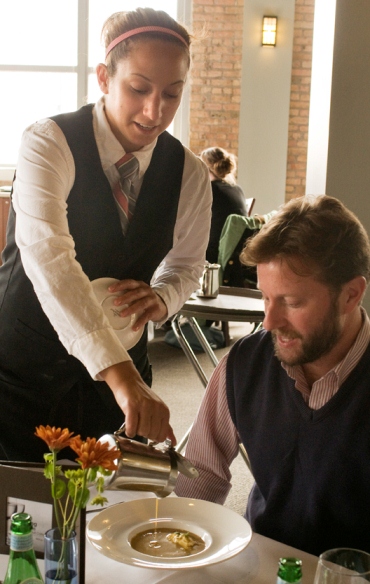Front of House: Navigating Turbulent Times
31 October 2010By Wendy Gay, CHE
 The day of the frumpy, inattentive waiter is gone. In the current economy, properly training wait staff has never been more important.
The day of the frumpy, inattentive waiter is gone. In the current economy, properly training wait staff has never been more important.
For most U.S. restaurants, this has been the roughest stretch in memory. Reports show that numbers are down in every part of the industry. Restaurant visits overall fell 1% in the quarter ending in June, marking the eighth consecutive quarterly drop. Experts predict it will take another year and a half to recover to pre-recession levels. While high-end restaurants are being hit the hardest, the effect is trickling down to every level. What are restaurants doing to increase their numbers? The answers are extremely important to every educator as we prepare future culinary professionals.
The two key elements garnering the most attention are affordability and experience. Restaurants at every level are finding creative ways to make their wares appear more affordable to get customers in their doors and then paying particular attention to the customer’s experience once they are there.
While some restaurateurs are discounting prices directly on their menus, many more are using special promotions and coupon programs as a way to attract customers. Wine tastings, wine-flight nights and half-price wine promotions (or similar ideas with martinis or beer) have reportedly been very successful with both male and female customers in restaurants ranging from Houlihan’s to more premier-level restaurants. Advertised nightly or monthly specials have had great response (Olive Garden’s bottomless bowl of pasta).
In addition, many are now filling seats by participating in coupon programs. While some include the coupons in their newspaper or magazine advertising, many are now utilizing online coupon programs such as restaurant.com or participating in Groupon. Others are sending special offers on Facebook and LinkedIn or through Tweets. While all of these methods offer the customer a reduced-price meal, the advantage of coupon programs is that they don’t reduce the printed menu prices. This keeps the restaurant from having to raise prices when financial circumstances become more solid.
The other key element is managing the experience of the diner. Once you have him or her in the restaurant, how do we make certain that he or she comes back? One part of that, of course, is the quality of the food. We need another article to describe some of the exciting trends and fusions that are finding a place in today’s kitchens. But the rest is how the customer is treated. We are seeing top-notch wait staffs make hamburger houses special. The day of the frumpy, inattentive waiter is gone. We can’t afford them. They cost us too much business. A combination of fun, warmth and skill is essential. Diners are greeted by smiling wait staff, who are trained in the steps of service, and who know seating positions rather than auctioning off the food. I am seeing skilled napkin folding in neighborhood restaurants. Hallelujah!
To put it more briefly, it is more important than ever that we make certain that every student who leaves our programs has a clear understanding of what happens in the front of the house, in addition to how to perform in the kitchen.
Wendy Gay is director of catering at The Westin Atlanta Perimeter North Hotel and teaches in the culinary department at The Art Institute of Atlanta.
Photo caption: At The Dining Room at Kendall College, Chicago, culinary-arts students are taught to serve Chef Peggy Ryan’s lentil soup with crème fraîche and fried celery leaves tableside to heighten the guest’s experience. Photo credit: Eric Futran
